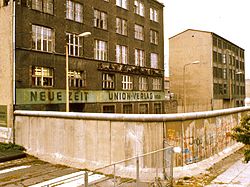
A section of the Berlin Wall (1984)
The end of the Cold War was a tumultuous, yet in many respects surprisingly peaceful time. There was a thaw in relations between the United States and the Soviet Union in the mid-to-late 1980s, as Soviet leader Gorbachev pursued a new approach to address the countries economic problems. In the late 1980s, many communist states in Eastern and Central Europe began to crumble. On 10 November 1989 the Berlin Wall, one of the most famous symbols of the Cold War, came down. Turmoil in the Soviet Union contributed to many Soviet Republics declaring independence, and by the end of 1991, the Soviet Union ceased to exist. After 45 years, the Cold War was over.
During this learning pathway you will watch one video lecture and complete two readings.
- Explore the events that led to the end of the Cold War
- Examine the policy approach of the United States in the aftermath of the Cold War
The end of the Cold War was a tumultuous, yet in many respects surprisingly peaceful time. There was a thaw in relations between the United States and the Soviet Union in the mid-to-late 1980s, as Soviet leader Gorbachev pursued a new approach to address the countries economic problems. In the late 1980s, many communist states in Eastern and Central Europe began to crumble. On 10 November 1989 the Berlin Wall, one of the most famous symbols of the Cold War, came down. Turmoil in the Soviet Union contributed to many Soviet Republics declaring independence, and by the end of 1991, the Soviet Union ceased to exist. After 45 years, the Cold War was over.
During this learning pathway you will watch one video lecture and complete two readings.
Objectives
Content is available under the
Creative Commons Attribution Share Alike License.
Privacy Policy | Authors